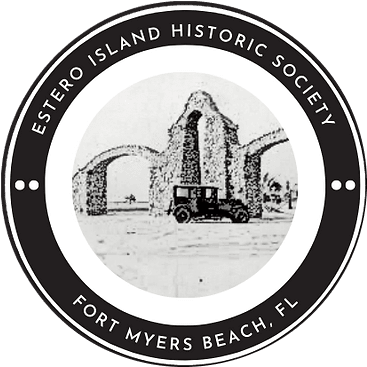Fisherman's Village
Estero Bay and Lenell Rd.
The story of the Charlotte Harbor region of southwest Florida begins with the estuarine system of which Estero Island has been a part since it became a barrier island around the year 1000, as dated by optical luminescence in 2015.
Today's documentation indicates the Calusa Indians fished these island waters year-round during the 1500's and 1700's with a vast knowledge of this highly productive, rich food environment. They were known as "fisher-gatherers".
By 1765, the Cuban "fisherfolk", as they were called, had established fishing operations within the San Carlos Bay area. They built thatched huts on stilts over the water for drying fish, as seen here, and storehouses for provisions to later trade with the Seminole Indians inland. By 1824, "fishing ranchos" were well established as dwellings and were later built on sheltered mangrove cove shorelines with net spreads. Sam Ellis chose the Calusa Mound, with higher ground, on Estero Island to establish his homesite for his family in 1865.
By the 1900s, commercial fishing was a way of life. Estero Island's "fisherman's village" had three houses on pilings in Estero Bay, located just south of Lenell Rd., directly behind what is today Santini Marina Plaza. The Santini family, pictured below, lived with their skiffs tied up to their home until the 1944 hurricane destroyed all three houses, leaving only pilings visible at low tide.
During the 20's, 30s, and 40s, local families provided "Ko-Kee-Na" broth, scallops, clams, oysters, mullet, sheepshead, snapper, redfish, snook, grouper, flounder, pompano, mackerel, and blue crabs to Bradley's "fish house" on Crescent St. and the "Kleen Fish" fish house on Miramar, on Ft. Myers Beach, as seen below.
The "Dixie" fish house on San Carlos Island, seen here below, opened in 1936 and continued to weigh in the local catches.
By 1950, "pink gold" shrimp had become a new part of the fishing industry. Shrimp boats tied up at the Columbia fishing docks on Ft. Myers Beach, as seen below, at the current site of the Matanzas Pass Restaurant, as well as today's San Carlos Island docks.
Today, the long-term sustainability of our fishing industries and natural resources within the estuaries and Gulf is questionable. While many state conservation and environmental protection agencies continue to address concerns for water and air quality, it is imperative they work more closely with the private sector on individual county issues in protecting and preserving our habitat, wildlife, and marine life in Florida. This millennium, we are reminded that we are the stewards of it all!
Click on this Link to Return to the Historic
Click on this Link to Continue the Tour to the Last Stop: South Drawbridge.
Contact
Your Voice Matters: Reach Out and Connect
At the heart of our mission is you—our community. Have something to share, a question to ask, or an idea to discuss? This is your space to be heard. Drop us a line using the form below, and let's embark on a dialogue that shapes our shared journey. Your thoughts drive us forward!
